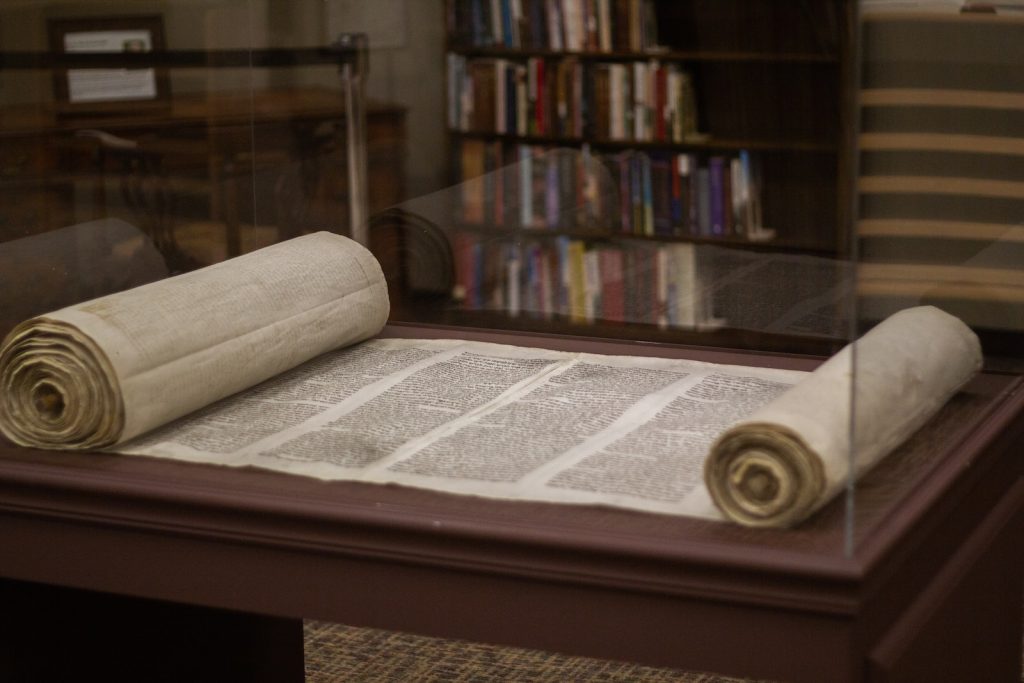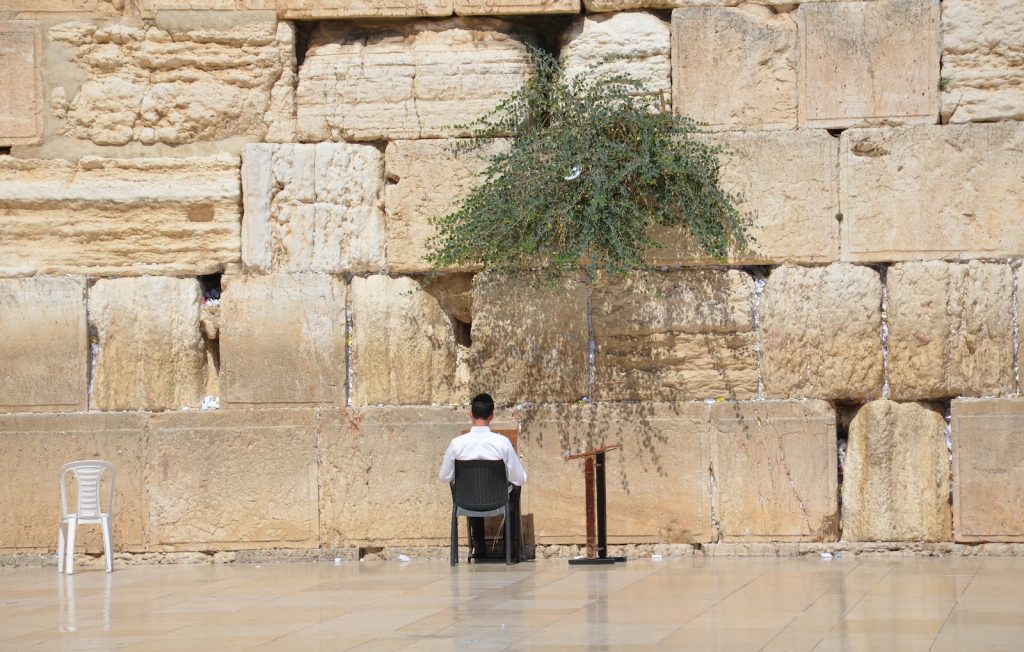The Hebrew Bible is a highly symbolic and ritualistic text that has been the basis of Jewish religious practices for thousands of years. One of the most intriguing aspects of the Hebrew Bible is the use of finger or hand movements in various rituals and ceremonies. These movements are believed to have deep symbolic meaning and are used to convey specific messages to the participants.

One of the most well-known finger or hand movements in the Hebrew Bible is the Priestly Blessing. This blessing is recited by the Kohanim, or Jewish priests, during certain religious services. The blessing is accompanied by a specific hand gesture, which involves raising the hands and spreading the fingers in a V-shape. This gesture is known as nesiat kapayim, or the “lifting of the hands,” and is believed to be a sign of openness and receptivity to God’s blessings.
Another finger or hand movement that is used in the Hebrew Bible is the placing of the hands on a sacrificial animal. This gesture is known as semikha and is used to transfer the sins of the person performing the sacrifice onto the animal. This gesture is believed to be a symbolic representation of the transfer of guilt from the sinner to the animal, which is then sacrificed as an offering to God.
Historical Context

Origins of Hand Gestures in Ancient Cultures
The use of hand gestures in religious rituals dates back to ancient civilizations. In many cultures, hand gestures were used to communicate with the divine and to express devotion. For example, in Hinduism, the mudras or hand gestures are used to express different emotions and to invoke different deities. Similarly, in Buddhism, hand gestures are used to symbolize different aspects of the Buddha’s teachings.
In ancient Egypt, hand gestures were used in religious rituals to symbolize different aspects of the gods and goddesses. The use of hand gestures was also prevalent in ancient Greece and Rome, where they were used in religious ceremonies to invoke the gods.
Significance in Hebrew Rituals
In the Hebrew Bible, hand gestures were used in religious rituals to express devotion and to symbolize different aspects of the divine. For example, the gesture of lifting the hands towards the heavens was used to express praise and gratitude to God. The gesture of laying hands on the head of an animal was used to transfer sins from the people to the animal, which was then sacrificed as an offering to God.
The use of hand gestures was also prevalent in the Jewish prayer service. For example, during the Torah service, some people raise their pinky fingers in the air for the line “And this is the Torah that God gave to Moses”. Similarly, during Birkat Kohanim, the Priestly Blessing, a V-shaped hand configuration is used.
Overall, the use of hand gestures in the Hebrew Bible was an important aspect of religious rituals and was used to express devotion and to symbolize different aspects of the divine.
Linguistic Analysis

Terminology and Definitions
The Hebrew Bible contains a rich vocabulary of hand and finger movements, which are used to convey a wide range of meanings and emotions. Some of the key terms used in the Bible to describe hand and finger movements include yad (hand), etzba (finger), and naga (touch). These terms are often used in combination with other words to create compound expressions that convey more nuanced meanings. For example, the phrase yad hashem (the hand of God) is used to describe God’s power and authority, while the phrase etzba elohim (the finger of God) is used to describe God’s intervention in the world 1.
Semantic Range of Gestural Vocabulary
The gestural vocabulary of the Hebrew Bible is complex and multifaceted, with many words having multiple meanings depending on the context in which they are used. For example, the word naga can mean “to touch” in a literal sense, but it can also be used metaphorically to mean “to afflict” or “to strike.” Similarly, the word yad can mean “hand” in a literal sense, but it can also be used to refer to a person’s power or authority 1.
Scholars have analyzed the semantic range of gestural vocabulary in the Hebrew Bible in order to better understand the nuances of meaning conveyed by different hand and finger movements. This analysis has revealed that the Bible often uses hand and finger movements to convey emotions such as anger, grief, and joy, as well as to express concepts such as blessing, cursing, and covenant-making 2. By studying the gestural vocabulary of the Hebrew Bible, scholars can gain a deeper understanding of the cultural and religious context in which the Bible was written, as well as the ways in which people in ancient Israel communicated with each other.
Theological Implications

Hand and finger movements in the Hebrew Bible are not just physical gestures, but they also carry significant theological implications. These movements are often used to symbolize important concepts such as covenant, blessing, purity, and sacrifice.
Symbolism of Hand Movements
Hand movements in the Hebrew Bible are often used as symbols of God’s power and authority. For example, the “finger of God” is a recurring motif in the Bible, representing God’s power and authority over creation. In Exodus 31:18, it is written that “God gave Moses two tablets of the covenant law, written by the finger of God.” This passage shows that God’s finger is the instrument of divine revelation and that it is through this instrument that God communicates with humanity.
Covenant and Blessings
Hand movements are also used to symbolize covenant and blessings. In Genesis 48:14, Jacob blesses his grandsons by crossing his hands and placing his right hand on the head of the younger son, Ephraim, and his left hand on the head of the older son, Manasseh. This gesture is significant because it shows that Jacob is intentionally blessing the younger son, Ephraim, over the older son, Manasseh. This gesture is a symbol of the covenant that God made with Abraham, Isaac, and Jacob, and it shows that God’s blessings are not based on human merit but on God’s grace.
Purity and Sacrifice
Hand movements are also used to symbolize purity and sacrifice. In Leviticus 16:21, the High Priest places his hands on the head of a goat and confesses the sins of the people of Israel. This gesture is significant because it symbolizes the transfer of the people’s sins to the goat, which is then sent into the wilderness as a symbol of the removal of sin. This gesture is also a symbol of the purity of the High Priest, who is able to approach God on behalf of the people because he has been purified through sacrifice.
In conclusion, hand and finger movements in the Hebrew Bible are not just physical gestures, but they also carry significant theological implications. These movements are often used to symbolize important concepts such as covenant, blessing, purity, and sacrifice. The use of these gestures helps to convey important theological concepts and to deepen the understanding of the reader.
Narrative Function

Finger and hand movements play a significant role in the Hebrew Bible, particularly in the narrative portions. These gestures serve different narrative functions, such as emphasizing a character’s emotions, highlighting a significant event, or conveying a message from God.
Gesture in Biblical Narratives
In biblical narratives, hand and finger gestures are often used to express emotions or convey a message. For example, in Genesis 4:5, God accepts Abel’s offering but rejects Cain’s. Cain becomes angry and his face falls. This gesture conveys Cain’s disappointment and frustration with God’s decision. Similarly, in Genesis 18:14, Sarah laughs when she hears that she will have a child in her old age. This gesture highlights her disbelief and skepticism.
Another example of gesture in biblical narratives is found in Exodus 17:11-12, where Moses raises his hands to the sky during the battle against the Amalekites. This gesture is a sign of prayer and trust in God’s power. As long as Moses holds his hands up, Israel prevails in the battle. When he lowers his hands, the Amalekites gain the upper hand. This gesture emphasizes the importance of faith and trust in God’s power.
Prophetic Actions and Signs
Prophets in the Hebrew Bible often use hand and finger gestures to convey a message from God or to perform a sign. For example, in Isaiah 20:2-3, the prophet Isaiah walks around naked and barefoot for three years as a sign to the people of Egypt and Cush that they will be taken captive by the Assyrians. This gesture is a powerful symbol of shame and humiliation, emphasizing the gravity of the coming judgment.
Another example is found in Ezekiel 4:1-3, where the prophet Ezekiel is instructed to lie on his left side for 390 days and then on his right side for 40 days as a sign of the coming judgment on Israel. This gesture is a powerful symbol of the severity and duration of the judgment to come.
In summary, finger and hand movements serve different narrative functions in the Hebrew Bible, such as emphasizing emotions, highlighting significant events, or conveying a message from God. These gestures are a powerful tool for communicating meaning and symbolism, and they add depth and complexity to the biblical narratives.
Modern Interpretations

Liturgical Uses Today
In modern Judaism, the use of hand gestures and movements during prayer is still prevalent. The most common hand gesture is the raising of hands, which is used to express praise and gratitude to God. This gesture is often accompanied by the recitation of prayers and blessings. Some Jewish communities also use hand movements during the recitation of specific prayers, such as the Shema.
Cultural Relevance and Adaptations
In addition to its liturgical uses, the practice of using hand gestures and movements has also found its way into popular culture. For example, the “priestly blessing” hand gesture, which involves the raising of the hands with the fingers spread apart, has become a popular symbol of Jewish identity. This gesture has been used in popular media, such as television shows and movies, to represent Jewish characters or themes.
Moreover, the use of hand movements has also been adapted by other cultures and religions. For instance, the Christian practice of crossing oneself involves the use of hand movements, which is similar to the Jewish practice of raising hands. Similarly, the Hindu practice of mudras involves the use of hand gestures to express certain ideas or concepts.
Overall, the use of finger or hand movements in the Hebrew Bible has continued to be relevant in modern times. Its liturgical uses have remained an important part of Jewish prayer and worship, while its cultural relevance has extended beyond the Jewish community.
Research Methodologies

Textual Analysis
One of the research methodologies used in the study of the use of finger or hand movements in the Hebrew Bible is textual analysis. This involves a close reading of the biblical text to identify the various instances where hand or finger movements are mentioned. Researchers have to examine the context in which these movements are used to understand their meaning and significance.
Textual analysis can be done through the use of concordances, which are tools that allow researchers to search for specific words or phrases in the biblical text. This can help identify all the instances where hand or finger movements are mentioned in the text. Researchers can then analyze these instances to determine their meaning and significance.
Archaeological Correlation
Another research methodology used in the study of the use of finger or hand movements in the Hebrew Bible is archaeological correlation. This involves the examination of archaeological evidence to determine if it supports the use of hand or finger movements mentioned in the biblical text.
Archaeological evidence can include artifacts such as pottery, inscriptions, and figurines. Researchers can examine these artifacts to determine if they depict hand or finger movements that are similar to those mentioned in the biblical text. This can help support the idea that these movements were used in ancient Israelite culture.
In addition to examining artifacts, researchers can also examine the layout of ancient Israelite temples and other religious sites. This can provide insight into the use of hand or finger movements in ancient Israelite religious practices.
Overall, the use of textual analysis and archaeological correlation are important research methodologies in the study of the use of finger or hand movements in the Hebrew Bible. These methodologies can help researchers gain a better understanding of the cultural and religious practices of ancient Israelites.
Conclusion

The use of finger or hand movements in the Hebrew Bible was a significant aspect of worship and ritual practices. The various gestures and movements had specific meanings and were often used to convey reverence, gratitude, and supplication to God.
Through the analysis of various texts and scholarly works, it is clear that hand placement gestures in the Hebrew Bible and Hittite ritual literature had two forms. One form was performed with two hands on persons in nonsacrificial contexts, and the other was performed with one hand on animals in sacrifice [1]. The gesture of raising both hands in praise or supplication is mentioned in twenty-four scriptural passages, of which twenty-two are from the Old Testament, one is from the New Testament, and one is from the Book of Mormon [4].
It is interesting to note that some of the hand movements used in the Hebrew Bible are still practiced today in Jewish prayer. For example, the V-shaped hand configuration used during Birkat Kohanim, the Priestly Blessing, is still used in modern-day Jewish prayer [5]. Other body movements, such as raising pinky fingers during the Torah service, are also still used, although their meaning and source are unknown [6].
Overall, the use of finger or hand movements in the Hebrew Bible was an important aspect of worship and ritual practices that conveyed specific meanings and emotions. These gestures continue to be used in modern-day Jewish prayer, connecting worshippers to their ancient traditions and beliefs.
[1] The Gesture of Hand Placement in the Hebrew Bible and in Hittite Ritual Literature, Brandeis University
[4] Gestures of Praise: Lifting and Spreading the Hands in Biblical Prayer, Brigham Young University
[5] Physical Movement in Jewish Prayer, My Jewish Learning
[6] Ibid.
Dr. Harlan Kilstein is a certified yoga teacher, hypnotherapist, and a teacher of the Law of Attraction since 1975.
After an immersion in yoga and his certification by the Yoga Alliance, he began studying mudras and invented Finger Healing.




